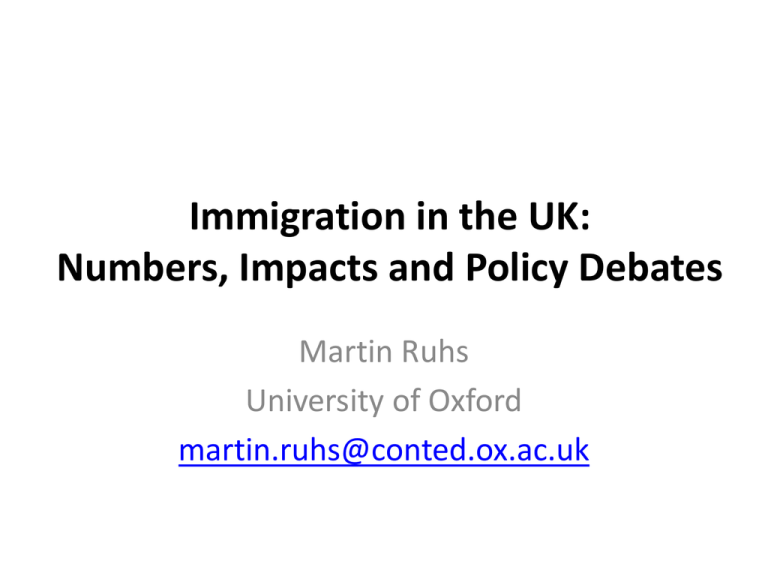Immigration in the UK
advertisement

Immigration in the UK: Numbers, Impacts and Policy Debates Martin Ruhs University of Oxford martin.ruhs@conted.ox.ac.uk This talk • UK Immigration policies since early 2000s: opening and closing • Numbers: what difference did EU enlargement make? • Impacts of EU migration: what do we know? • Policy debates 1: – how to reduce growing reliance on migrant workers, especially in lower-skilled occupations? – how to regulate highly skilled migration and students? Opening and closing doors • “Managed Migration” Policies before EU enlargement: The economic benefits of immigration • EU enlargement 2004: No restrictions on EU8 workers • EU enlargement 2007: Restrictions on EU2 workers • Since 2008: Points-based System for non-EU immigration • Since 2010: Net-migration target and cap on skilled non-EU workers (plus more restrictions on family and student immigration from outside EU) • Big current policy question: what to do about EU immigration? Migration to and from the UK Top ten sending countries (by COB) A8 and A2 migrants in the UK EU8 Migration flows much larger than predicted (but still less than a fifth of all inflows) EU8 nationals have among the highest employment rates in the UK EU8 nationals are, on average, better educated than UK-born workers, but most EU8 are in LS jobs EU8 migrants are among the lowest earners in UK EU2 Immigration Impacts of A8 immigration Impacts of EU8 immigration • Labour markets – Econometric studies find no evidence of significant adverse effects on wages or employment; but qualitative research with employers finds preference for migrants in some sectors; sectoral/occupational effects? • Fiscal effects – Only one study: finds pos. effects during 200409: low wages outweighed by high employment rates Impacts of EU8 immigration • Public services (provision and consumption) – Significant data limitations – Research (NIESR 2011) finds that, in 2009-10, the per capita consumption of education, health and social care services of recent migrants was lower than that of the UK-born population – Many anecdotes and public debates about some public services (incl schools and hospitals) not coping with pace of change; funding issues – EU8 less likely to be in social housing than UKborn; but debates about allocation of limited social housing Impacts of EU8 immigration • So overall: – data limitations and gaps in evidence – Employers and migrants clearly benefited – Fiscal effects likely positive (and small) but “pace of change” issues – Debates and evidence gaps about impacts on specific low-waged labour markets Policy debates Policy debates 1: EU immigration • EU8 “problem” for public opinion: Low-skilled; “out of control” • EU8 major political problem for Labour Party; Labour Leader says that it was “wrong” to open up to A8 • Key policy challenge: how to reduce reliance on migrants, esp. in low-skilled jobs EU8 immigration • Immigration and public policy; system effects – Supply side approach (Conservatives) – Demand side approach (Labour) • Access to benefits • A2 migration Policy debates 2: students and skilled immigration from outside EU • Students biggest category in immigration statistics; gvt has restricted student migration but not universities; future trajectories? Length of stay? Impacts? • Highly skilled workers: impacts? how to attract and select? Investors and entrepreneurs always tension between “protecting” and “globalising” national labour markets; effectiveness of resident labour market test? Immigration in the UK: Numbers, Impacts and Policy Debates Martin Ruhs University of Oxford martin.ruhs@conted.ox.ac.uk Appendix











